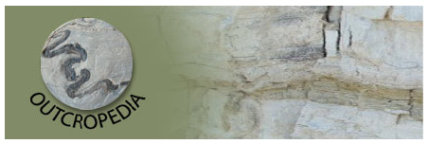Caption: Graben is the downthrown part of rock within extensional tectonics such as rifts.
Grabens are commonly bound by horsts and can be formed in a linear,
non-linear or radial (as collapse crater) style at different geological scales. The
photograph shows two oppositely dipping normal faults forming a spectacular cm-scale graben.
This structure formed within the sequence of Devonian alternating layers of calc-schist, metalimestone
turbidite (brown) and thin bands of laminated marble (white). Metamorphic units is
result from Early Cimmerian orogeny. No drag of the faulted unit characterizes it as a specific
type of flanking structure. The throw (vertical displacement) on the fault is ~2 cm (follow the marker layer).
Extensional faulting within compressional orogeny is a crux and attracts geologists.
Extensional tectonism and its related structures may occur during as well as after the
contractional history of a collisional orogeny. It is important in structural analysis and tectonic
modelling to know which structures are synorogenic and which formed during the postcontractional stage. Synorogenic extensional structures are related to orogeny-internal
features that cause relatively local instabilities in an overall contractional regime. By contrast
significant postorogenic extensional deformation implies true extension at the scale of the
orogenic belt and crust. Accordingly, orogeny can be affected by
contractional and extensional deformations overprinting each other and producing complex
structural architectures (such as type-II superposed folds). Small-scale extension is commonly
related to local thrust faults and brittle-ductile shear zones. From the Khabr Mountain.
Structural zone of Sanandaj-Sirjan metamorphic-ophiolitic Complex, SW of the city of Baft,
Kerman province, Iran (Location 28°52´04ʺN, 56°23´56ʺE). The coin radius is 1.25 cm. PhotoID800
Caption: Graben is the downthrown part of rock within extensional tectonics such as rifts.
Grabens are commonly bound by horsts and can be formed in a linear,
non-linear or radial (as collapse crater) style at different geological scales. The
photograph shows two oppositely dipping normal faults forming a spectacular cm-scale graben.
This structure formed within the sequence of Devonian alternating layers of calc-schist, metalimestone
turbidite (brown) and thin bands of laminated marble (white). Metamorphic units is
result from Early Cimmerian orogeny. No drag of the faulted unit characterizes it as a specific
type of flanking structure. The throw (vertical displacement) on the fault is ~2 cm (follow the marker layer).
Extensional faulting within compressional orogeny is a crux and attracts geologists.
Extensional tectonism and its related structures may occur during as well as after the
contractional history of a collisional orogeny. It is important in structural analysis and tectonic
modelling to know which structures are synorogenic and which formed during the postcontractional stage. Synorogenic extensional structures are related to orogeny-internal
features that cause relatively local instabilities in an overall contractional regime. By contrast
significant postorogenic extensional deformation implies true extension at the scale of the
orogenic belt and crust. Accordingly, orogeny can be affected by
contractional and extensional deformations overprinting each other and producing complex
structural architectures (such as type-II superposed folds). Small-scale extension is commonly
related to local thrust faults and brittle-ductile shear zones. From the Khabr Mountain.
Structural zone of Sanandaj-Sirjan metamorphic-ophiolitic Complex, SW of the city of Baft,
Kerman province, Iran (Location 28°52´04ʺN, 56°23´56ʺE). The coin radius is 1.25 cm. PhotoID800
Photograph: Seyed Tohid Nabavi
